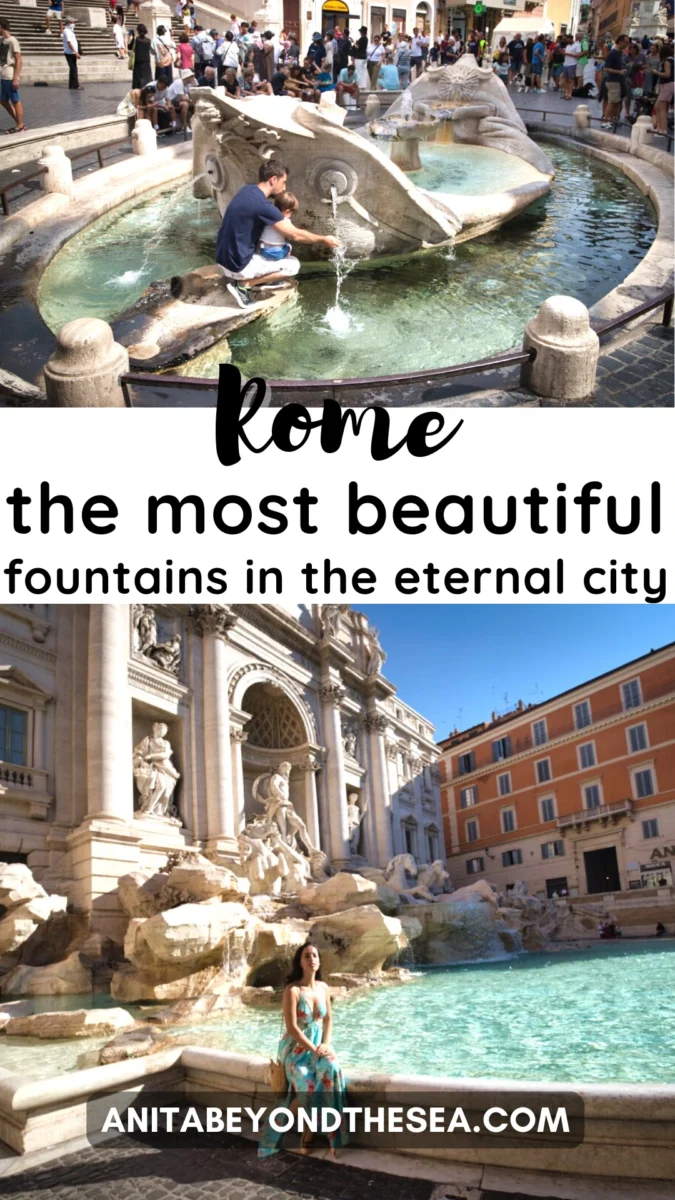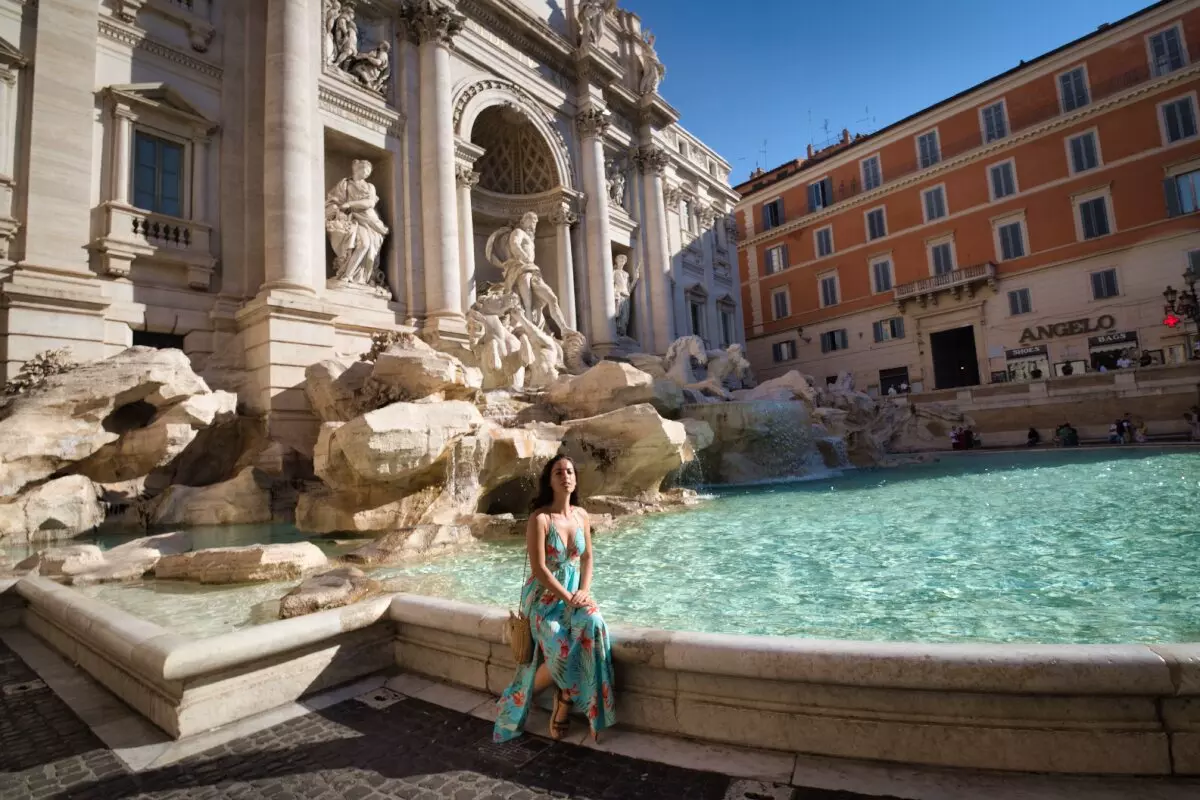Exploring the Eternal City of Rome is an awe-inspiring journey through history, art, and architectural marvels. Among its many treasures, the city boasts a remarkable collection of fountains that grace its squares, and gardens. From grand Baroque masterpieces to hidden gems tucked away in charming corners, Rome’s fountains are not merely functional water features but captivating works of art that embody the city’s rich heritage and artistic excellence. Join us as we delve into the stories and craftsmanship of the most beautiful fountains in Rome. Where mythological creatures come to life and ancient legends are immortalized.
Disclosure: anitabeyondthesea.com is reader-supported. When you make a reservation through links on my site, I may earn an affiliate commission, at no extra cost for you. That will help me keep the blog up and running. Thank you!
Table of Contents
- Trevi Fountain: A Grand Marvel of Baroque Splendor
- Fontana dei Quattro Fiumi: A Symbol of Global Harmony
- Fontana del Moro: A Captivating Encounter with Moorish Culture
- Fontana delle Tartarughe: An Elegant Union of Art and Nature
- Fontana del Pantheon: Celebrating Architectural Brilliance
- Fontana dei Tritoni: An Artistic Triumph of Mythological Proportions
- Fontana delle Naiadi: Mythical Encounters in Modern Surroundings
- Fontana della Barcaccia: A Delicate Symbol of Resilience
- Fontana delle Api: A Hidden Gem in Rome's center
- Fontana delle Rane: A Charming Tribute to Frogs
- Fontana delle Anfore: A Timeless Tribute to Roman Heritage
- Fontana dell'Acqua Paola: A Majestic Vista Over the Eternal City
- Fontana dei Dioscuri: Equestrian Elegance in Piazza del Quirinale
- Fontana dei Libri: A Literary Delight
- Frequently Asked Questions
- Wanna learn more? Check out this guided tour
- Grab your camera and go explore the most beautiful fountains in Rome
Did you know that Rome is the city with the highest quantity of fountains in the world? Even if most of them have not survived the test of time and are now in disuse.
Trevi Fountain: A Grand Marvel of Baroque Splendor
The Trevi Fountain stands as Rome’s most iconic fountain and a masterpiece of Baroque architecture. Its majestic scale, intricate sculptures, and dramatic backdrop of the Palazzo Poli make it a must-visit attraction. Tossing a coin into its crystal-clear waters ensures a return trip to Rome, perpetuating its status as a symbol of love and luck.
The centerpiece of this Baroque masterpiece is a colossal statue of Neptune, flanked by two Tritons as if emerging from the depths of the sea. Water cascades from rock formations, symbolizing the natural elements, while statues representing Abundance and Salubrity add to the fountain’s opulence.
Adorned with exquisite reliefs, the fountain’s facade depicts scenes from Roman mythology, evoking a sense of ancient tales brought to life. The Trevi Fountain’s allure reaches its pinnacle at night when it becomes a captivating spectacle, bathed in the soft light that accentuates the sculptural details and creates an almost ethereal atmosphere.
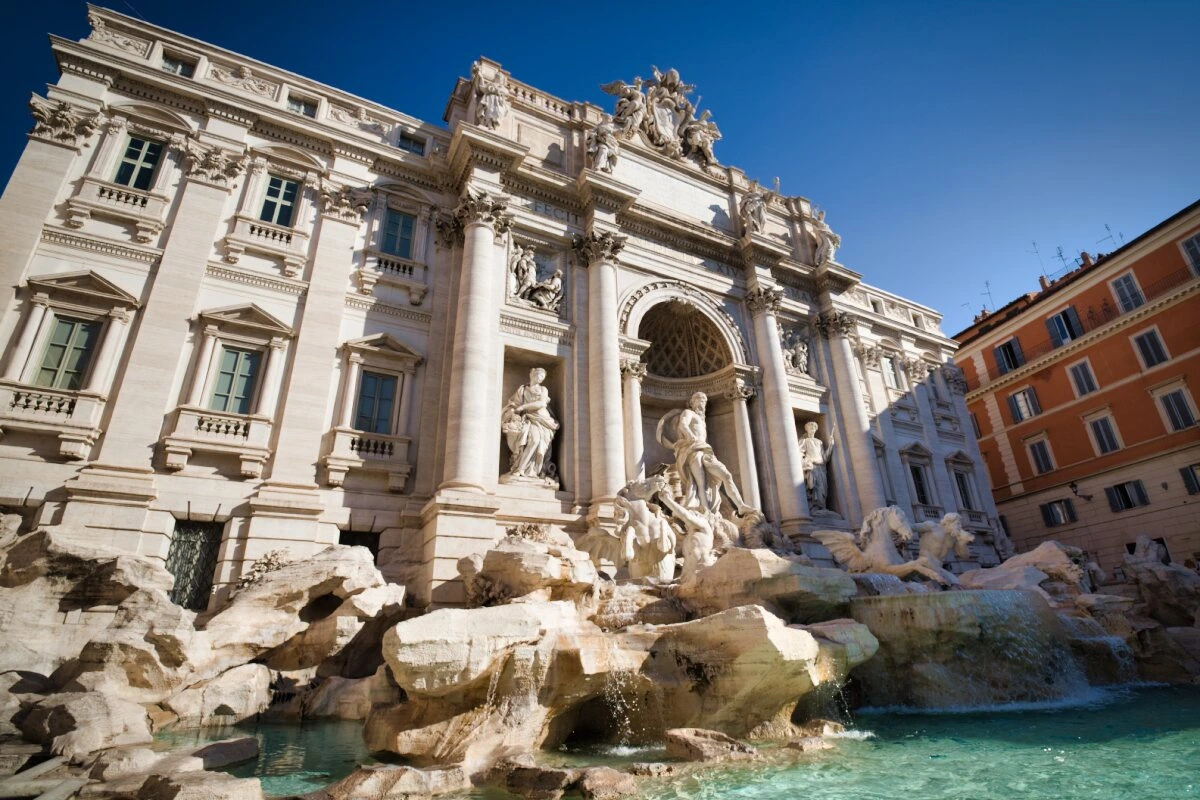
Tossing three coins into the Trevi Fountain
The tradition of tossing three coins into the Trevi Fountain holds a special place in the hearts of visitors to Rome. It is believed that this ritual ensures a return to the Eternal City, grants good fortune and fulfills wishes. Here’s how the tradition works:
- Tossing the First Coin: When standing with your back to the fountain, you should use your right hand to throw the first coin over your left shoulder. This act is believed to guarantee your return to Rome in the future.
- Tossing the Second Coin: The second coin is thrown to seek love or romance. Again, standing with your back to the fountain, you would use your right hand to toss the coin over your left shoulder. It is said to enhance the chances of finding a romantic partner or strengthening an existing relationship.
- Tossing the Third Coin: The third coin is thrown to ensure good fortune and wishes to come true. Following the same ritual as before, you would toss the coin over your left shoulder using your right hand. It is believed that this gesture brings luck, success, and the realization of desires.
The coins collected from the fountain are regularly gathered and donated to charitable causes, providing an additional positive impact on the community. So, as you partake in this age-old tradition, you will not only “make your wishes come true” but also contribute to doing a good deed.

Tips for visiting the Trevi Fountain
As one of Rome’s most iconic landmarks Trevi Fountain gets crowded, VERY crowded, almost every time of the year. If possible, avoid visiting during weekends and especially from 11 AM to 2 PM in the Summer months.
Wanna enjoy the Trevi Fountain all by yourself? Go early, at 6-7 AM, the colors will be better and you won’t have people around to take some memorable pictures.
Fontana dei Quattro Fiumi: A Symbol of Global Harmony
The Fontana dei Quattro Fiumi (which translates as Fountain of the Four Rivers), stands as a majestic masterpiece in the heart of Rome’s Piazza Navona. Designed by the renowned sculptor and architect Gian Lorenzo Bernini, this magnificent fountain is a true testament to his artistic genius.
The centerpiece of the fountain is an imposing Egyptian obelisk rising high above, symbolizing the connection between ancient civilizations. Surrounding the obelisk are four colossal statues representing the major rivers of the continents known at the time: the Nile, Danube, Ganges, and Rio de la Plata.
Each statue is intricately carved, showcasing Bernini’s mastery in capturing dynamic movement and realistic expressions. Among the sculptures two deserve a special mention: the Nile is depicted with a veil over his face, as the river’s source was unknown at that time. While the Rio de la Plata is shown sitting on a pile of coins, representing the newfound wealth from the Americas.
Tips for visiting Piazza Navona
If it’s your first time in Rome, you probably don’t know this, but Piazza Navona is a tourist trap. Its shops and restaurants are more expensive than in other areas. Although it’s also understandable as having lunch or a cocktail in the iconic square has indeed a special feeling.
If you are willing to save money though, ditch Piazza Navona bars and restaurants to eat in Regola or Trastevere instead, both are a few minutes away. While in case the Roman Forum and Colosseum are your next stop, have a lunch break in the Monti neighborhood.
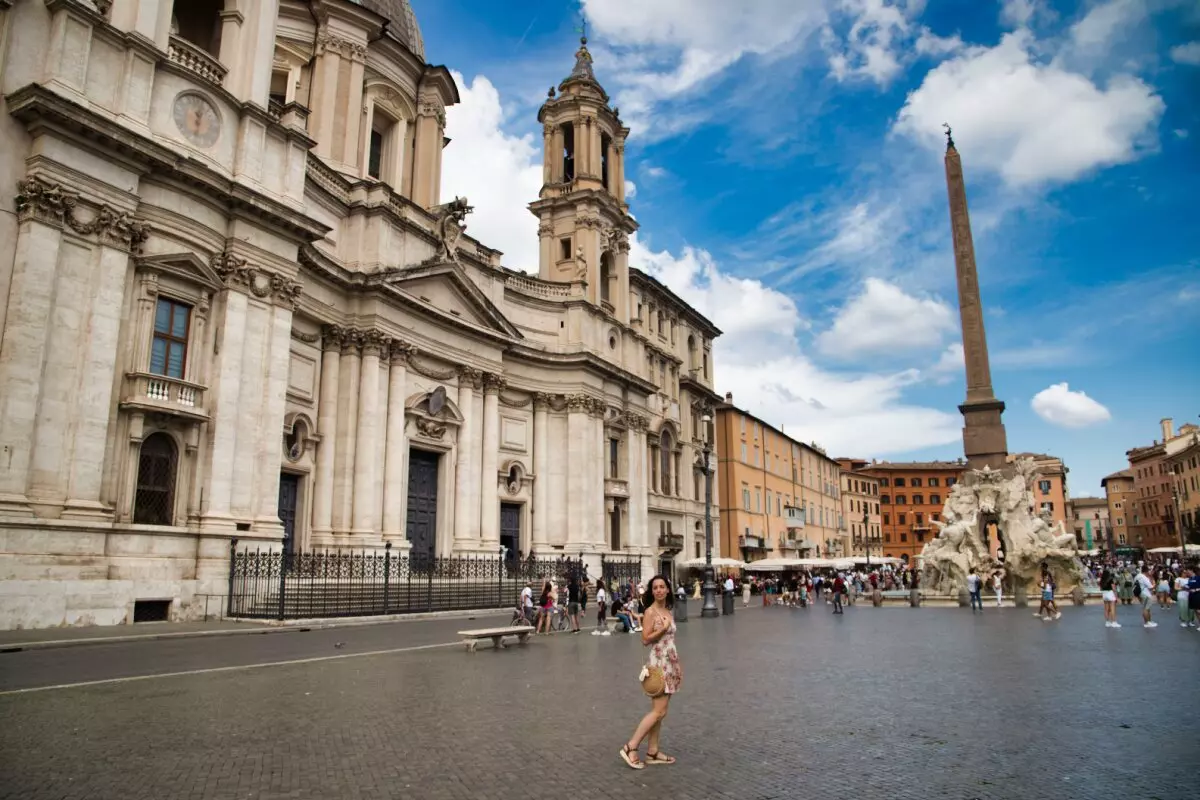
Fontana del Moro: A Captivating Encounter with Moorish Culture
The Fontana del Moro (Fountain of the Moor), is a captivating fountain nestled in the heart of Rome’s Piazza Navona. Designed by Giacomo della Porta in the late 16th century, this fountain’s allure lies in its unique portrayal of a Moorish figure engaged in a dramatic struggle with a dolphin.
The Fontana del Moro is not only a remarkable artistic creation but also a symbol of Rome’s historical connections with different cultures. The representation of the Moor pays homage to the city’s encounters with diverse civilizations and their contributions to its rich tapestry of art and history.
Over the centuries, the fountain has undergone several renovations and modifications. In the 17th century, Gian Lorenzo Bernini added four additional dolphins to the fountain, enhancing its aesthetic appeal and the playfulness of the water features.
Some history about Piazza Navona
Piazza Navona is one of Rome’s most beautiful squares and a symbol of the wealth and power of the Pamphili family. Anciently Domiziano’s Stadium, between the 16th and 17th centuries the Pamphili family financed some monumental works that changed the aspect of the square.
Three fountains were added: Fontana del Moro, Fontana del Nettuno, and Fontana dei Quattro Fiumi, but also the imposing Sant’Agnese in Agone Church and the majestic Palazzo Pamphili.

Fontana delle Tartarughe: An Elegant Union of Art and Nature
The Fontana delle Tartarughe (Fountain of the Turtles), is a hidden gem nestled in the small Piazza Mattei. Designed by Taddeo Landini and completed by Giacomo della Porta in the 16th century, the Fontana delle Tartarughe is a delightfully whimsical creation. The fountain consists of a circular basin adorned with intricate carvings and a central pillar on which four bronze figures support a second basin, where the turtles are diving in.
What sets this fountain apart is its endearing backstory. Originally the statues were supporting dolphins. But a problem of water pressure forced to remove them. As the fountain now looked unbalanced, about 60 years after its completion the turtles made their appearance on the top basin, adding the unique feature that makes this fountain so iconic.

Fontana del Pantheon: Celebrating Architectural Brilliance
The Fontana del Pantheon is a stunning architectural masterpiece located just a stone’s throw away from the iconic Pantheon in Rome. This elegant fountain, also known as the Fountain of the Pantheon Obelisk, perfectly complements the grandeur and magnificence of its neighboring ancient temple.
Designed by Giacomo Della Porta in the 16th century, the Fontana del Pantheon features a majestic obelisk towering above a polygonal basin. The obelisk itself is an ancient Egyptian relic, originally built during the reign of Pharaoh Ramses II. Its inclusion in the fountain adds a sense of historical significance and a connection to the city’s past.
Tips when visiting
It would be a pity to visit the fountain without entering the Pantheon. Although, in recent years to they introduced a small fee to enter inside, but it’s still a 100% worth it! These tickets come also with an audio guide.

Fontana dei Tritoni: An Artistic Triumph of Mythological Proportions
The Fontana dei Tritoni, or Fountain of the Tritons, is a captivating work of art located in the heart of Rome. Situated in the Piazza Barberini, this magnificent fountain serves as a stunning representation of the city’s artistic heritage and love for mythological themes.
The fountain features two powerful Triton figures, mythical sea creatures with the upper body of a man and the tail of a fish. These muscular beings are depicted in dramatic poses, supporting a large shell-shaped basin from which water cascades gracefully.
The fountain’s location in Piazza Barberini is also interesting. When the project was completed it received several critics due to the choice of the area that is often flooded by the Tiber. However, the presence of the Temples of Hercules Victor and Portunus in the background contributes to the charm of the fountain.

Fontana delle Naiadi: Mythical Encounters in Modern Surroundings
The Fontana delle Naiadi, or Fountain of the Naiads, is a captivating and evocative fountain located in Rome’s Piazza della Repubblica. Designed by Mario Rutelli in the late 19th century, this fountain is a celebration of mythological beings known as Naiads, nymphs associated with water and natural springs.
The Fontana delle Naiadi is a harmonious blend of classical elements and Art Nouveau style. The fountain’s design incorporates intricate details, flowing lines, and a sense of fluidity that complements the theme of water. The combination of bronze, marble, and water creates a captivating visual display and a soothing atmosphere.
Fun fact about Fontana delle Naiadi
When the fountain was completed, the statues of the Naiads were considered too sensual, because of their poses and the reflections of the water on their bronze bodies. For many years the fountain was covered by a fence, until finally its official inauguration in 1901.
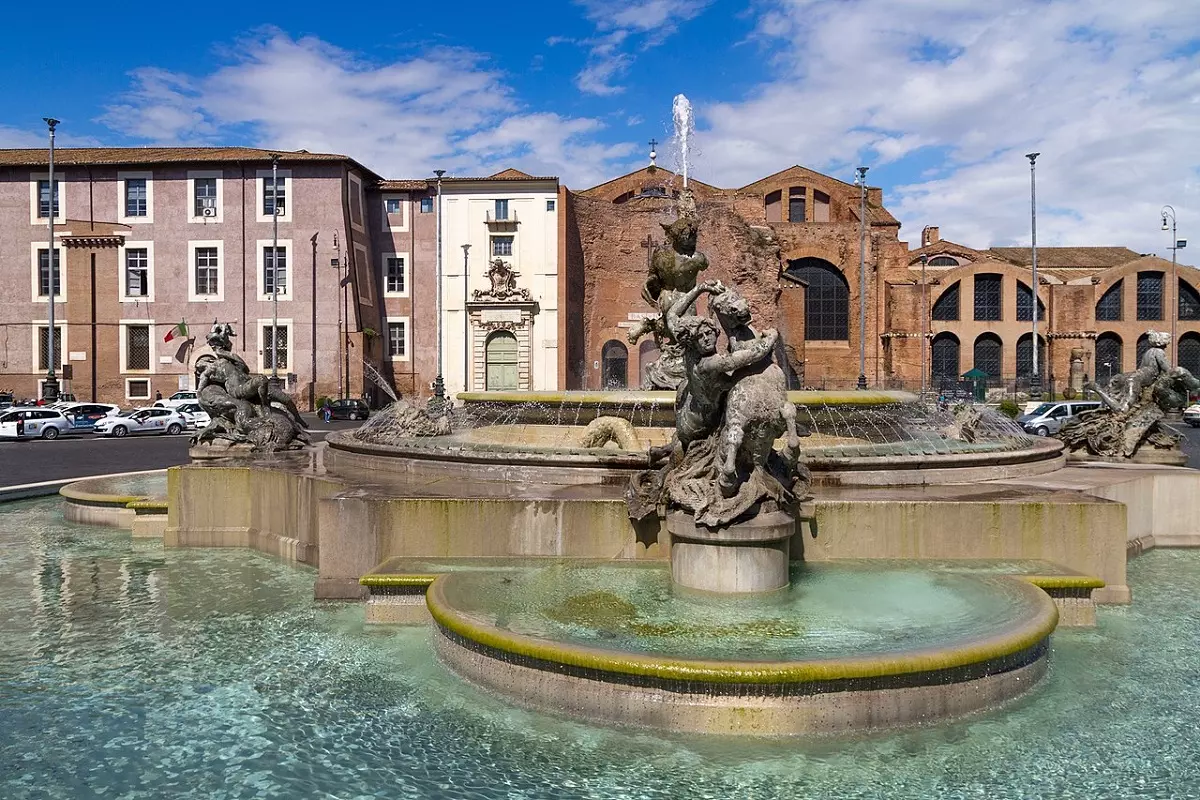
Fontana della Barcaccia: A Delicate Symbol of Resilience
Fontana della Barcaccia (Fountain of the Old Boat), is a charming and iconic fountain nestled at the foot of the Spanish Steps in Rome. Designed by Pietro Bernini, the father of renowned sculptor Gian Lorenzo Bernini, this fountain carries a unique and captivating story.
The Fontana della Barcaccia takes the shape of a half-sunken boat, with water overflowing from its hull. According to the legend, during the Great Flood of the Tiber River in 1598, a small boat was left stranded at this very spot.
Following the commission by Pope Urbano VIII in 1627, Pietro Bernini created a fountain in its likeness. After the death of his father, Gian Lorenzo Bernini completed the fountain in 1629.

Fontana delle Api: A Hidden Gem in Rome’s center
The Fontana delle Api (Fountain of the Bees), is a charming and lesser-known fountain tucked away in Rome’s Piazza Barberini. Designed by Gian Lorenzo Bernini, the fountain’s name pays homage to the delightful addition of marble bees adorning its structure.
The fountain is made by a large scallop shell open that has on the inside 3 bees, the heraldic symbol of the Barberini family. Despite its modest size, the fountain’s artistry and historical significance make it a hidden gem worth discovering.
Fun(and tragic) fact about Fontana delle Api
When Bernini completed the fountain he made a Latin inscription carved on the fountain that mentioned ‘the twenty-second year of his pontificate.’ However, during the inauguration, there were still two months remaining until this anniversary.
This small discrepancy became the source of ridicule among the Romans. And a satirical remark captured the sentiment of the common people: ‘After having sucked the whole world dry, the Barberini now sought to suck even the essence of time!’
To quell the scandal, the Pope’s nephew, Cardinal Francesco Barberini, ordered the removal of the final “I” from the inscription. So that the inscription became ‘the twenty-first year of the pontificate.’ Omen of bad luck, Urban VIII, indeed, passed away shortly after, a mere eight days before reaching the completion of his twenty-two years in his papal reign.
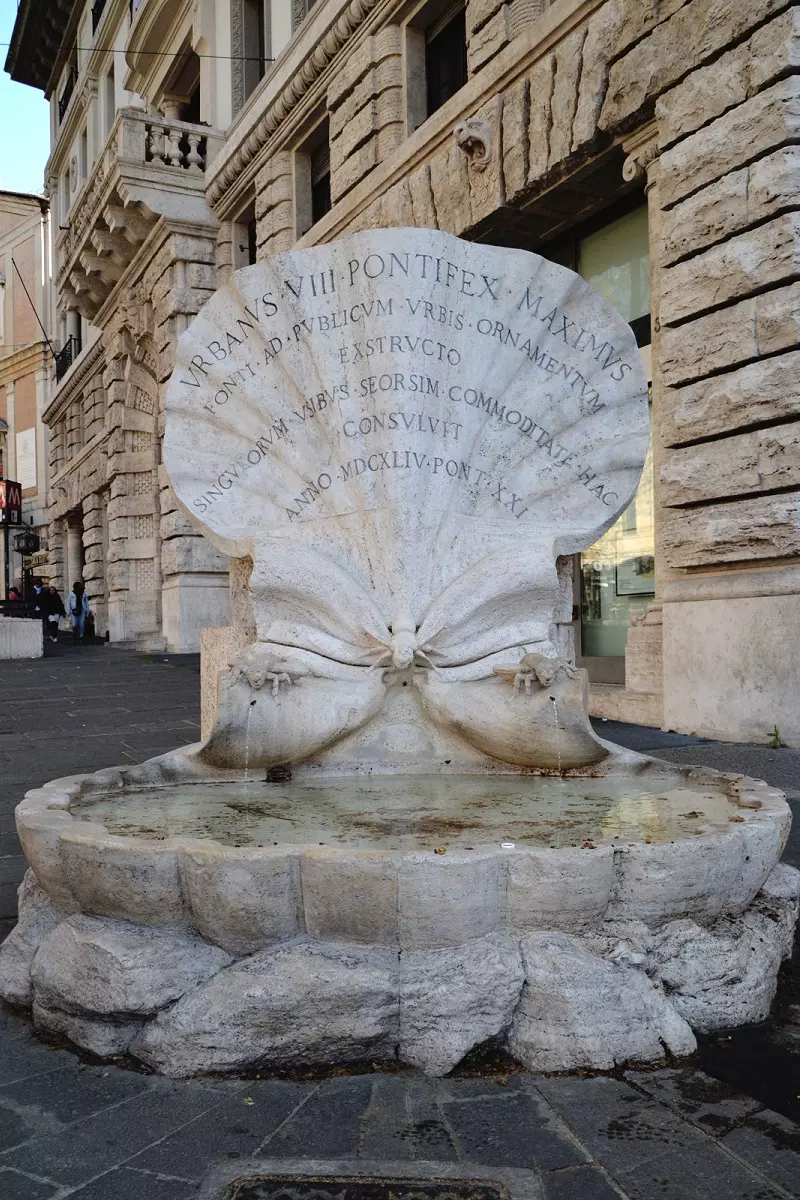
Credits to Rita Batacchi. License.
Fontana delle Rane: A Charming Tribute to Frogs
The Fontana delle Rane, or Fountain of the Frogs, is a delightful and whimsical fountain located in the heart of Rome’s Coppedé neighrborhood.
Designed by the Italian architect Gino Coppedé in 1924, the fountain features a circular basin adorned with four large frogs positioned on the rim. In addition to the four, eight smaller frogs spill water in an overhanging basin. The fountain which is in neo-baroque style is a celebration of Bernini’s fountains and notably the Fontana delle Tartarughe and delle Api. A large bee sits in the lower basin.
Fun fact about Fontana delle Rane
In 1965 The Beatles, who were singing in the Eternal City, ended up touring in Coppede area after their exhibitions. It was a very hot evening and after a few drinks, they went looking to refresh themselves inside Fontana delle Rane. La bella vita style!
Note: it is severely prohibited to bathe inside any of the fountains in Rome as they are historical monuments.

Fontana delle Anfore: A Timeless Tribute to Roman Heritage
Testaccio, where Fontana delle Anfore stands, was once the economic center of ancient Rome. Ships carrying their precious cargoes of food, spices, wine, and oil were stocked there.
Due to the nature of the oil, amphorae that were used to transport the precious liquid, were thrown after their first utilization. That’s how through the centuries Mount Testaccio, an artificial hill of 36 made with the fragments of the amphorae, was born.
Following the institution of Testaccio as a Rione, in 1927 architect Pietro Lombardi created the Fontana delle Anfore. A tribute to the neighborhood’s past, the fountain is a pyramid of travertine amphorae, undoubtedly more resistant than clay.

Fontana dell’Acqua Paola: A Majestic Vista Over the Eternal City
The Fontana dell’Acqua Paola, also known as Fontanone del Gianicolo, is a majestic fountain located on Janiculum Hill in Rome. Its construction was commissioned by Pope Paul V in the early 17th century to bring fresh water to the Trastevere and Borgo neighborhoods.
The structure of the fountain features a massive semicircular basin adorned with ornate carvings and sculptures. Even though there were previously 5 smaller basins situated under the columns. The fountain is crowned by a large stone emblem representing a dragon and an eagle. They are the symbol of the papal family: the Borghese.
Tips for visiting Fontana dell’Acqua Paola
The fountain’s strategic location on Janiculum Hill offers panoramic views of the city, and it may sound inviting to go there for observing the sunset and the city lights coming alive. But, if your schedule allows you, go at 11.30 to be ready to reach Piazza Garibaldi for the noon cannon.

Fontana dei Dioscuri: Equestrian Elegance in Piazza del Quirinale
The Fontana dei Dioscuri is an iconic fountain located in Piazza del Quirinale in Rome. Designed by the Italian sculptor Domenico Fontana in the late 16th century, the fountain was again modified around 1782.
Who were the Dioscuri? From Greek sons of Zeus, the Dioscuri were Castor and Pollux. In the narrative they appear as two powerful warriors from Greek mythology, representing a symbol of strength and courage.
The Fontana dei Dioscuri serves as a focal point in the Piazza del Quirinale, where resides the President of the Italian Republic. Beyond its aesthetic appeal, the fountain holds historical and symbolic significance. It pays homage to the Dioscuri, who were revered as protectors and patrons of Rome.

Fontana dei Libri: A Literary Delight
The Fontana dei Libri (Fountain of the Books) is located on Via degli Staderari which was previously called Via dell’Università (Street of the University). The reason behind this is to pay tribute to the neaborhing University of La Sapienza.
The fountain is situated within a niche crowned by a rounded arch and features a deer head, a symbol of the S. Eustachio district. On the sides, there are four ancient books, two on each side. While water flows from two bookmark-shaped spouts on the upper volumes and from two additional spouts on the lower volumes, collecting in the semi-circular basin below.
Similarly to Fontana delle Anfore, Fontana dei Libri was built as a tribute to the ancient symbols of Rome’s districts throughout the city. The travertine composition was designed by architect Pietro Lombardi in 1927.

Frequently Asked Questions
Can you drink the fountains’ water?
You’d better not! In fact, the water is recycled and it’s not purified. Although, you will notice many small fountains spread all over the city. Their water is potable, very fresh, and will save you some money. Just don’t drink the water from the monumental fountains.
Can you dip in the fountains in Rome?
Unless you are the Beatles (read Fontana delle Rane fun facts), or filming one of Federico Fellini’s movies, you cannot dip in the fountains. And if you try, you will get a salty fine or in some cases, you could get to jail.
Wanna learn more? Check out this guided tour
Interested in a guided tour of the most beautiful Fountains and Squares in Rome? With this two hours guided walking tour, you will learn many anecdotes and fun facts about Rome’s history.

Grab your camera and go explore the most beautiful fountains in Rome
These twenty fountains in Rome showcase the city’s rich artistic and cultural heritage. Each fountain having its unique charm, whether it’s through intricate sculptures, mythological representations, historical significance, or serene natural surroundings. So grab your camera and go explore the Eternal City!
By the way, did you know that you can “conquer” Rome in a day? With this detailed itinerary (complete with a helpful map), you will be able to see Rome’s most iconic landmarks in a day! And in case you are planning to visit the Colosseum don’t forget to check out our helpful guide to book the tickets or guided tours.
Have you liked our selection of the most beautiful fountains in Rome? Sharing is caring!

